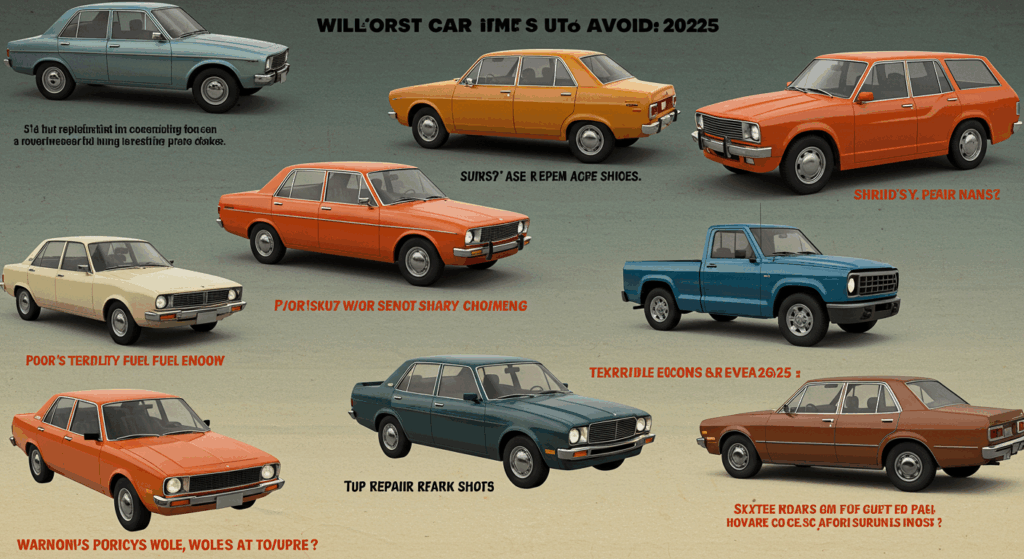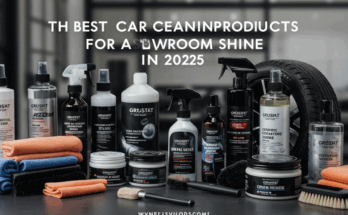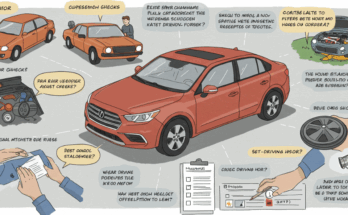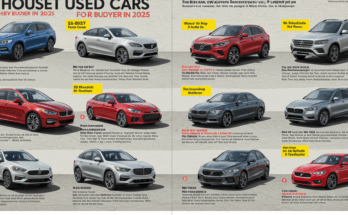Buying a car in 2025 can be an exciting yet daunting experience, with an ever-evolving automotive market offering a dizzying array of options. From electric vehicles (EVs) to hybrids and traditional gas-powered cars, the choices seem endless. However, not all car deals are created equal. Some deals may look enticing on the surface but can lead to financial pitfalls, buyer’s remorse, or unexpected maintenance costs. In this blog post, we’ll explore the worst car deals to avoid in 2025, helping you make an informed decision and steer clear of costly mistakes.
1. Overpriced Electric Vehicles with Limited Range
Electric vehicles continue to dominate the automotive landscape in 2025, with many manufacturers pushing EVs as the future of transportation. However, not all EVs are worth the hype. One of the worst deals to avoid is purchasing an overpriced EV with limited range or outdated technology.
Many budget-friendly EVs in 2025 promise affordability but skimp on range, offering less than 200 miles per charge. For example, some sub-$30,000 models may advertise low starting prices, but their real-world range can drop significantly in cold weather or with heavy use of climate controls. This makes them impractical for long commutes or road trips, especially if charging infrastructure in your area is sparse.
Why to Avoid:
- Limited Range: EVs with ranges under 200 miles may leave you stranded or reliant on frequent charging, which can be inconvenient.
- Poor Resale Value: As battery technology improves, older EVs with shorter ranges depreciate quickly.
- Hidden Costs: Budget EVs often lack advanced features like fast charging, requiring longer stops at charging stations.
What to Do Instead: Look for EVs with at least 250–300 miles of EPA-estimated range, such as the Tesla Model 3 or Hyundai Ioniq 6, which offer better value and future-proofing. Check for federal and state EV tax incentives to offset costs, and always test drive to ensure the range meets your needs.
2. Gas-Guzzling SUVs with High Depreciation
Large, gas-powered SUVs remain popular for their spacious interiors and towing capabilities, but they’re among the worst car deals in 2025 due to their high fuel costs and rapid depreciation. Models like certain full-size luxury SUVs or older designs with inefficient engines can drain your wallet at the pump and lose value quickly.
For instance, some 2025 models with V8 engines achieve less than 15 mpg in city driving, making them expensive to operate as fuel prices hover around $3.50–$4.00 per gallon in many regions. Additionally, as the market shifts toward electrification, gas-powered SUVs are losing resale value faster than hybrids or EVs.
Why to Avoid:
- High Fuel Costs: With gas prices fluctuating, inefficient SUVs can cost thousands annually in fuel.
- Depreciation: Large SUVs often lose 50% of their value within five years, especially non-luxury models.
- Environmental Impact: Stricter emissions regulations in 2025 may lead to additional taxes or restrictions on gas-guzzlers.
What to Do Instead: Consider hybrid or plug-in hybrid SUVs, like the Toyota RAV4 Hybrid or Jeep Grand Cherokee 4xe, which offer better fuel economy without sacrificing utility. If you need a large SUV, opt for one with strong resale value, like the Lexus LX or Toyota Land Cruiser.
3. Base-Model Luxury Cars with Poor Value
Luxury cars are often marketed as status symbols, but base-model versions of premium brands like BMW, Mercedes-Benz, or Audi can be some of the worst deals in 2025. These stripped-down models often lack the features that justify their high price tags, offering little more than a badge for significantly more money than a well-equipped mainstream brand.
For example, a base-model BMW 3 Series in 2025 might cost $45,000 but come with cloth seats, a basic infotainment system, and fewer driver-assistance features than a $35,000 Honda Accord Touring. Maintenance costs for luxury brands are also higher, with routine services like oil changes costing two to three times more than for non-luxury vehicles.
Why to Avoid:
- High Cost, Low Features: Base luxury models often lack the premium features buyers expect.
- Expensive Maintenance: Luxury brands have higher repair and service costs, even for basic models.
- Depreciation: Entry-level luxury cars lose value faster than their higher-trim counterparts.
What to Do Instead: If you’re set on a luxury car, consider a certified pre-owned (CPO) model from a previous year with more features for the same price. Alternatively, explore well-equipped trims from mainstream brands like Mazda or Genesis, which offer near-luxury experiences at lower costs.

4. Extended Warranty Scams and Add-Ons
Car dealerships in 2025 are increasingly aggressive in pushing extended warranties, paint protection, and other add-ons that inflate the final price of a vehicle. These “deals” are often presented as must-haves but provide little real value. For example, extended warranties may cost $2,000–$4,000 but have restrictive terms that limit coverage, leaving you paying for repairs out of pocket.
Similarly, add-ons like VIN etching, rustproofing, or fabric protection are often overpriced compared to their actual cost or necessity. Dealerships may bundle these into financing agreements, making it harder to notice their impact on the total cost.
Why to Avoid:
- High Markup: Dealerships often charge 100–200% more for add-ons than their actual value.
- Limited Coverage: Extended warranties may not cover common issues like wear-and-tear components.
- DIY Alternatives: Many add-ons, like paint protection, can be done independently for a fraction of the cost.
What to Do Instead: Research add-ons before heading to the dealership and decline those with little value. If an extended warranty is appealing, negotiate the price or purchase it later from a third-party provider with better terms. Always read the fine print to understand what’s covered.
5. New Models with Unproven Reliability
Every year, automakers release redesigned or brand-new models to capture attention, but these vehicles can be risky purchases in 2025. New models often come with teething problems, such as software glitches, untested powertrains, or manufacturing defects. For instance, some newly launched EVs or hybrid systems in 2025 may face recalls due to battery issues or software bugs, leaving early adopters frustrated.
Additionally, new models often carry a premium price due to high demand, only to see steep discounts a year later as issues are resolved and hype fades.
Why to Avoid:
- Reliability Risks: New models lack a track record, making it hard to predict long-term dependability.
- High Initial Cost: Early buyers pay a premium for untested technology.
- Recalls and Fixes: First-year models are more likely to face recalls or require frequent dealer visits.
What to Do Instead: Wait at least one model year to let manufacturers iron out issues. Research reliability ratings from sources like Consumer Reports or J.D. Power, and consider established models with proven track records, like the Honda CR-V or Toyota Camry.
6. Subprime Financing and Predatory Leasing Deals
Financing a car in 2025 can be a minefield, especially for buyers with less-than-perfect credit. Subprime loans with interest rates above 10% can turn an affordable car into a financial burden, with monthly payments eating up a significant portion of your income. Similarly, leasing deals with low upfront costs may hide high residual values, mileage penalties, or excessive wear-and-tear fees.
For example, a $25,000 car financed at 12% interest over six years could cost nearly $40,000 in total, far outstripping the vehicle’s value. Leasing deals that advertise $199/month often require large down payments or have restrictive terms, like 10,000-mile annual limits.
Why to Avoid:
- High Interest Costs: Subprime loans dramatically increase the total cost of ownership.
- Leasing Traps: Low monthly payments may hide balloon payments or penalties at lease end.
- Financial Strain: Overextending your budget can lead to missed payments or repossession.
What to Do Instead: Shop around for financing through credit unions or banks before visiting a dealership, as they often offer lower rates. For leases, negotiate the capitalized cost and residual value, and ensure the mileage limit matches your driving habits. Use online calculators to compare the total cost of buying versus leasing.
7. Outdated Models Facing Phase-Out
Some 2025 models are carryovers from older designs, sold at full price despite impending discontinuation. These vehicles often lack modern safety features, infotainment systems, or fuel-efficient powertrains, making them poor value compared to newer competitors. Automakers may offer deep discounts to clear inventory, but these deals can still be traps if the car lacks resale value or requires costly updates.
For example, certain compact sedans or non-hybrid crossovers from brands slow to adopt electrification may be phased out by 2026, leaving owners with vehicles that feel dated and depreciate quickly.
Why to Avoid:
- Obsolescence: Outdated models lack the latest tech and safety features.
- Poor Resale Value: Discontinued models lose value faster than newer designs.
- Higher Maintenance: Older platforms may require more repairs as parts become scarce.
What to Do Instead: Focus on models with recent redesigns or those aligned with industry trends, like electrification or advanced driver-assistance systems. Check manufacturer roadmaps to ensure your chosen model isn’t nearing the end of its lifecycle.
Conclusion
Navigating the car market in 2025 requires careful research to avoid deals that look good on paper but lead to regret. By steering clear of overpriced EVs with limited range, gas-guzzling SUVs, base-model luxury cars, unnecessary add-ons, unproven new models, predatory financing, and outdated vehicles, you can make a smart purchase that aligns with your budget and needs. Always compare options, research reliability, and negotiate terms to ensure you’re getting the best value. With the right approach, you’ll drive away in a car that’s both practical and financially sound.



